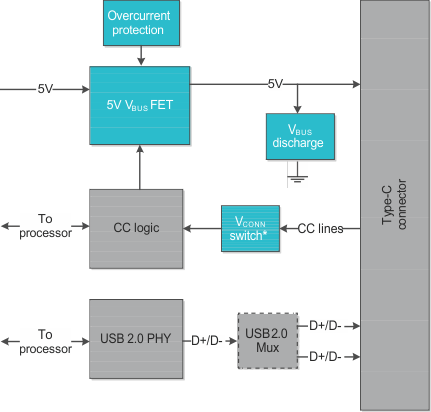SLYY109B February 2021 – March 2022 HD3SS3212 , HD3SS460 , TPD4S311A , TPD6S300A , TPD8S300 , TPS25740A , TPS25750 , TPS65982 , TPS65983B , TPS65987D , TPS65988 , TPS65994AD , TUSB1042I , TUSB1046A-DCI , TUSB1210 , TUSB1310A , TUSB320 , TUSB542 , TUSB544 , TUSB546A-DCI , TUSB564
- At a glance
- Authors
- 3
- Introduction
- Data and power roles
- USB Type-C UFP sink: USB 2.0 without USB PD
- USB Type-C DFP: USB 2.0 without USB PD
- USB Type-C DRP/DRD USB 2.0 without USB PD
- USB Type-C DRP/DRD: USB 2.0 with USB PD
- USB 3.1 Gen 1 (SuperSpeed) and Gen 2 (SuperSpeed+)
- Alternate Mode
- USB Type-C pinout and reversibility
- Conclusion
- References
USB Type-C DFP: USB 2.0 without USB PD
Another simple and common application is a DFP USB 2.0 without USB PD, as shown in Figure 4. One example is a 5-V AC/DC adapter.
Figure 4 represents the blocks necessary for a USB Type-C DFP USB 2.0 without USB PD. Note the similarities to Figure 2 with a few extra blocks added, while the CC logic block is still the same. In the case of a DFP, the device presents Rp and monitors for a pulldown caused by Rd. Once Rp detects a pulldown, the DFP knows that there is a device connected and provides 5 V. Providing 5 V only on the VBUS line after detecting a device (cold-plugging), versus always providing 5 V is a new feature introduced in USB Type-C.
The USB 2.0 ULPI PHY is the same as in the previous section. For applications that do not transfer data, such as a 5-V wall adapter, you can omit the USB 2.0 ULPI PHY froFigure 4m the design. Because USB Type-C implements cold-plugging, adds a 5-V VBUS field-effect transistor (FET). As a result, the design requires a switch for the 5-V rail.
Additionally,the USB Type-C specification requires that all sources monitor current and protect themselves if a sink tries to draw in excess of what it can supply [1]. This is where the overcurrent protection block comes into play. These two blocks can be integrated into the point-of-load power converter, or integrated into the USB Type-C device.
 Figure 4 USB Type-C DFP USB 2.0 without
USB PD block diagram.
Figure 4 USB Type-C DFP USB 2.0 without
USB PD block diagram.Figure 4 also includes the VBUS discharge block. When no device is attached, VBUS should sit at 0 V. The USB Type-C specification requires a source to discharge VBUS within 650 ms of a detached sink [1]. VBUS discharge is often integrated into a USB Type-C device, but can also be integrated with a bleeder resistor.
VCONN can power passive electronically marked or active cables (cables that support USB PD communication and provide a method for determining cable characteristics ) by switching 5 V onto the unused CC line (see the appendix). Figure 3 shows that one CC line in the USB Type-C cable connects Rp to Rd, while the other is left floating (a passive cable) or pulled down to ground with Ra (a passive electronically marked or active cable).
VCONN is required for all applications that support USB 3.1 speeds or power delivery higher than 3 A [1]. The VCONN switch is also required if you want to support active cables, such as longer-distance cables that require signal conditioning with an integrated redriver or retimer.
TI’s portfolio of USB Type-C source controllers are a good fit for DFP USB 2.0 data without USB PD applications. These devices include CC logic, a 5-V VBUS FET, overcurrent protection, VBUS discharge and a VCONN switch. To learn more about these devices, see the USB Type-C portal on TI.com.